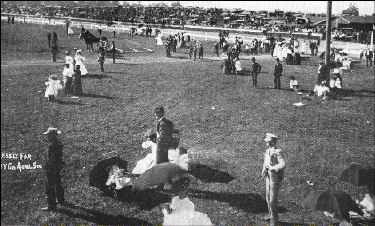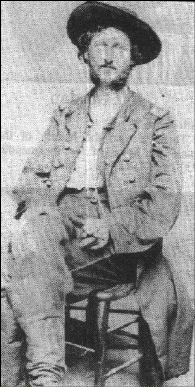This
photo out of a 1910 fair book shows the harness racing track looking north from the
grandstands.
There are plenty of fans outside the track and in the infield.

As the great Shelby County Fair gets under way this week,
county residents will gather to participate in perhaps our oldest community activity.
Early records trace the genesis of the fair to a meeting called by William Murphy, then
the auditor of Shelby County, on August 21, 1839. The first fair was held on October 17,
1840, and was a one day affair. The early history of the event, and its various locations
in the beginning years, are topics for another day. Horse racing, and the off track action
that surrounded the sport, have always been a central part of the fair. Significant sums
of money were wagered on the races in the early years. The recent announcement that a
night of racing at the fair will be canceled this year comes as a disappointment to some.
Before the recent rise in popularity of such sports as football, baseball and basketball, horse racing
captivated the attention of sports fans. The great horses had names as well known as the
sports stars of today. Never was there a horse that generated more local excitement than
Joe Gales. He was the talk of Sidney in the late 1860's. This is the story of the rise and
fall of that great horse.
Joe Gales first saw the light of day in an Auglaize County horse barn in 1859. An ugly
gray in color with a droopy rump, this horse was headed for an unpromising life. The mid
1860's was not a good time to be a man of fighting age or a horse. The U. S. government
was paying $105 a head for horses because of their tragic rate of deaths on the
battlefield. Russell Botkin, who was a partner with George Yager in a Sidney livery
business, bought a lot of 17 Auglaize County horses for resale to a government agent.
Botkin collected the horses together for
inspection by Peter Mesler, the resident government agent living in Dayton. Mesler
accepted the lot except for the ugly gray, who was thought ‘unfit’ to serve his
country. Thus rejected, Joe Gales became a driving horse for George Yager. Yager trained
him as a pacer, and Joe Gales achieved some success in the county fair races, pacing the
mile in just over three minutes. Yager tired of him, sold him to a stock dealer, but then
bought him back for $60.
Joe's red letter day occurred in 1865 when an astute
businessman, Colonel John Fry of Mississippi, purchased him and shipped him to Vicksburg,
of that state. Returning to Sidney a year later, Joe Gales astonished the county fair
goers and area horsemen by handily winning every race in which he was entered. Fry
selected a trainer from the Cincinnati area named Doolan to further the career of the
motley gray pacer.
Cincinnati businessman Court Dodd purchased a half interest in Joe Gales for $1,700.
When Court Dodd had his charge ready, he was taken to the prestigious eastern circuit.
Racing in Philadelphia, Washington, Pittsburgh, Buffalo and other locations, Joe Gales
never lost. His best time for the paced mile was 2:23, which was considered a top time in
those days. The author of a Sidney Journal article of February 6, 1896, recalled
those days: "He did not lose a single race, though pitted against White Cloud, and
the other cracks of the day. Money flowed like water in the pockets of the owners...The
gray horse, looking fit only to go to his own funeral, was one of the equine kings of the
country."
The triumphant return of Joe Gales to Sidney was a sight to behold. All the residents
celebrated the fast but homely looking horse. Sidney residents laughed when the champion
was challenged by the owners of two other horses. The opponents were Tipp Cranston, a
beautiful blood bay from Tippecanoe owned by Dr. Cranston, and Centerville Maid, of
Hamilton.
The match race was held at the fairgrounds. Virtually all the town's residents
attended. The bettor's money flowed freely. The odds on the challengers were long. Tension
gripped the air as the starting bell rang. The horses broke from the gate evenly, but
immediately, a gasp went up from the crowd as Joe Gales went up in the air. Tipp Cranston
won the race. Amid the howling protests of Joe Gales' backers, it was determined that a
wheel on his sulky had broken. Tipp Cranston's owner refused a demand for a rematch after
Colonel Fry on behalf of Joe Gales, who shouted: "I will bet you $5,000 that we can
beat you in 20 minutes."
A twist of fate developed that day that proved the undoing of the great Joe Gales.
Thomas McGeehan, the owner of Centerville Maid, was so impressed by Joe Gales that he
traded his horse and $500 for Sidney's gray champion. McGeehan, a reputed gambler and
participant in a whiskey ring, mistreated the great horse. He raced him too frequently,
often after the horse had been 'doctored'. It was said that Joe Gales took on the morals
of his owner, often 'throwing' races.
McGeehan took him west to Kansas, in hopes of arranging a lucrative stakes race. When
the arrangements fell through, his owner sold a half interest in Joe Gales for a load of
coal. Joe Gales reportedly spent his old age on a farm near Toledo, Ohio. The fate of his
cruel owner, however, can be reported with certainty.
McGeehan was reported to have committed
several murders in the Cincinnati area. One occurred while he was engaged in a combination
fight and wrestling match. While McGeehan and his opponent, a man named Myers, were on the
ground, McGeehan shot him, apparently with a revolver he had hidden in his coat. The horse
trader went on trial for murder. He was defended by Clement Vallandigham, the
notorious anti-war protester and Democratic candidate for governor of Ohio. The reader may
remember Vallandigham was almost assassinated in Sidney by soldiers from the 11th Michigan
regiment in September, 1864, when he journeyed here to give a speech.
Vallandigham rose
before the jury to give his final argument and convince the jury that McGeehan had acted
in self defense. These two men, whose careers separately intertwined with Sidney, were
both destined to meet violence in the end. As Vallandigham's voice rose, and he hammered
home his case on self defense, he grabbed a revolver to demonstrate his point. The sound
of the gun discharging stunned those in the court room. Vallandigham fell over dead. The
jury got the point, and acquitted McGeehan.
A short time later, McGeehan was in a Hamilton saloon late one night. A man approached
the establishment and fired one shot through the window. McGeehan toppled from his stool.
Some suspected the murderer was the brother of Myers, the man McGeehan had killed. No
arrest was ever made.

Lt. Col. John C. Fry
of Mississippi purchased Joe Gales, hired a trainer from Cincinnati,
and turned the horse
into one of the best ever.
[ Back to Sports Index ] |

